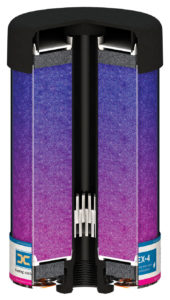In any fluid-containing reservoir, differential pressures occur through thermal expansion and contraction of the fluid, or during the filling and emptying process, causing water and contaminants to enter the fluid reservoirs.
Air drawn into the reservoir will heat up to unit operating temperature, which allows the partial pressure of the heated air to retain atmospheric moisture in vapor form.
As the air in the reservoir cools down, it loses its ability to retain the water vapor, and condenses. This condensed water forms droplets on the inside surfaces of the reservoir which group together and enter fluid, resulting in contamination. Water contamination of the lubricating oil dramatically shortens the life of the lubricant and strips additives. This results in accelerated wear of the component. 
The most common types of breather vents are standpipes or pipe fitting with a hood to prevent large objects from entering the reservoir. The problem with these simple breather vents is that they allow many abrasive contaminants to enter the reservoir as the unit draws in and expels air.
The solution in the past has been to fit disposable paper filter units to the standpipe or to fit complicated “oil bath type” filters to trap incoming contamination. Both of these solutions are relatively ineffective as the disposable filters generally only filter down to approximately 50 microns. Oil bath type filters also require frequent clean out and replenishment of the oil reservoir in the bath. Most importantly, neither method is capable of controlling water vapor.
Using a desiccant breather on the vent of your equipment will help mitigate both dirt and moisture ingression. Desiccant breathers, which can filter down to 0.3 micron in some models, are filled with a hygroscopic agent that traps ad adsorbs moisture contained in the air entering the filter. It also removes moisture from within the reservoir as the unit breathes out. By controlling moisture both outside and inside the reservoir, many of the problems typically caused by water contamination are prevented.
Desiccant breathers are available in a variety of different models to suit the needs of your application. For example, some breathers integrate check valves into the design to isolate the system from ambient conditions—great for high humidity environments or systems that run intermittently, while others incorporate a metal bodies to protect against extremely harsh environments.


Leave a Reply